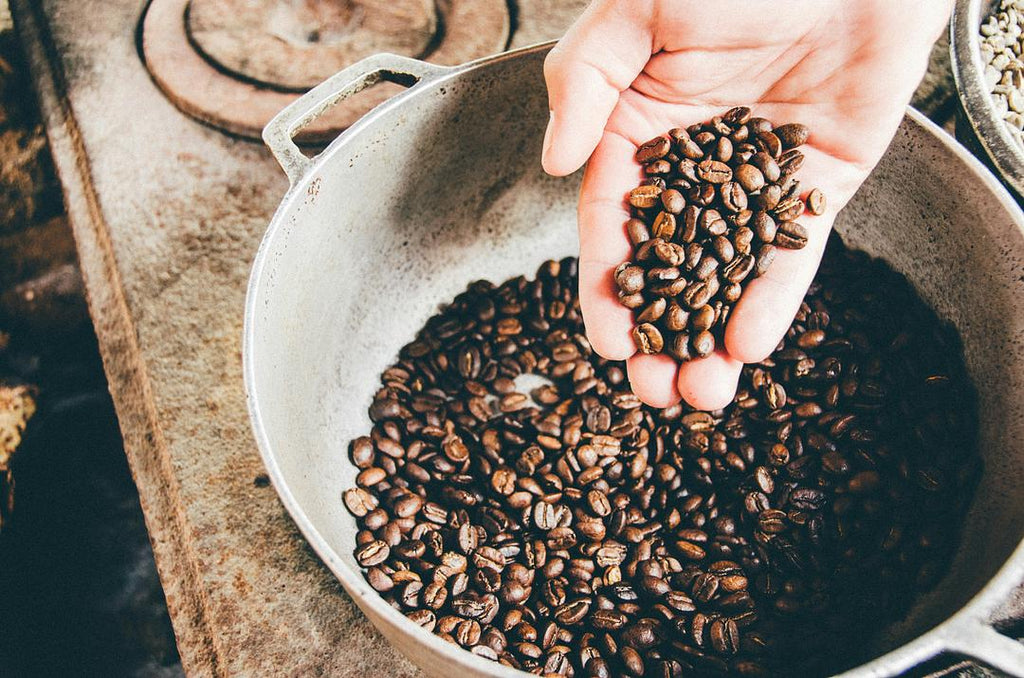
Artisan vs. Commercial: The Impact of Roasting on Flavor Profiles

The allure of artisan coffee lies in its meticulous craftsmanship and dedication to unlocking the full potential of each carefully selected bean. In a world where mass-produced, generic coffee dominates the market, artisan roasters stand out as beacons of quality and authenticity.
These passionate artisans approach coffee roasting as an art form, meticulously honing their skills to coax out the unique flavors and aromas hidden within each batch of beans. Their commitment to the craft is evident in every step of the process, from sourcing the finest single-origin beans to carefully monitoring the roasting process to ensure optimal results.
By focusing on small-batch production and hands-on techniques, artisan roasters can adapt to the nuances of each coffee variety, showcasing the distinct characteristics that make each cup a sensory adventure. This attention to detail sets artisan coffee apart from its commercial counterparts, offering coffee enthusiasts an unparalleled experience in every sip.
What is artisan coffee roasting?
Artisan coffee roasting is a labor of love that prioritizes quality, craftsmanship, and the pursuit of exceptional flavor profiles. Unlike large-scale commercial roasting, which often prioritizes efficiency and consistency over individuality, artisan roasters focus on small-batch production, allowing them to meticulously control every aspect of the roasting process.
The artisan approach begins with sourcing high-quality, often single-origin beans from specific farms or micro-lots. By fostering direct relationships with farmers and cooperatives, artisan roasters can ensure that they receive the best possible raw materials to work with. This commitment to ethical sourcing not only supports the livelihoods of coffee growers but also contributes to the overall sustainability of the industry.
Once the beans arrive at the roastery, the artisan roaster's expertise comes into play. Using their knowledge of the bean's origin, varietal, and processing method, they carefully develop a roast profile that will highlight the coffee's unique characteristics. This process involves continuously monitoring the beans as they roast, making subtle adjustments to temperature, time, and airflow to achieve the desired flavor profile. The result is a coffee that showcases the terroir of its origin, with a complex array of flavors and aromas that evolve as the coffee cools.
The art of small-batch roasting
- Customization: Small-batch roasting allows artisan roasters to tailor their approach to each specific bean, ensuring that the final product is a true reflection of the coffee's potential.
- Adaptability: By working with smaller quantities, artisan roasters can quickly adjust their techniques based on the beans' response to heat, allowing them to fine-tune the roast profile for optimal results.
- Freshness: Small-batch roasting ensures that coffee is always enjoyed at its peak freshness, as the beans are roasted closer to the time of consumption, preserving their vibrant flavors and aromas.
Unlocking the potential of single-origin beans
- Terroir expression: Single-origin beans, sourced from a specific farm or region, offer a unique snapshot of the growing conditions, processing methods, and varietal characteristics that shape the coffee's flavor profile.
- Varietal exploration: Artisan roasters often showcase lesser-known or rare coffee varieties, allowing coffee enthusiasts to explore the diverse range of flavors and aromas that the world of coffee has to offer.
- Traceability: By working directly with farmers and cooperatives, artisan roasters can provide transparency about the origins of their beans, connecting coffee lovers with the stories and people behind each cup.
Artisan coffee roasting is a testament to the dedication and passion of those who strive to elevate the coffee experience. By focusing on small-batch production, hands-on craftsmanship, and the celebration of single-origin beans, artisan roasters invite coffee enthusiasts on a sensory journey that explores the full spectrum of coffee's potential. As you savor a cup of artisan-roasted coffee, you can appreciate the care and expertise that went into every step of the process—from seed to cup.
How does commercial roasting differ from artisan roasting?
Commercial coffee roasting operates on a different scale and set of priorities compared to artisan roasting. The emphasis is on producing large volumes efficiently, with a focus on achieving a uniform flavor profile that appeals to the average coffee drinker. This process relies on precise control and automation, ensuring that each batch aligns with the desired consistency.
To achieve this reliability, commercial roasters often create blends from various origins. These blends are carefully formulated to ensure the final product maintains a stable taste despite changes in bean supply or quality. This approach can limit the expression of individual flavor notes, aiming instead for a balanced and predictable cup.
Characteristics of commercial roasting
Uniform roasting levels: Commercial roasters often prefer roasting beans to a darker level. This choice results in a consistent flavor profile, characterized by rich, deep notes, while minimizing the beans' inherent acidity.
Large-scale production: The need to supply a broad market requires the use of industrial-grade equipment capable of handling significant quantities of coffee beans. This scale allows for a steady production line, meeting consumer demand without interruption.
Balancing flavor and efficiency
Blend creation: To maintain a consistent taste, commercial roasters develop precise blends. These blends undergo extensive testing to ensure they deliver the same flavor experience with every batch, accommodating fluctuations in bean characteristics.
Technological integration: Commercial facilities leverage advanced technology to manage roasting variables such as heat and duration. This automation helps in achieving consistency across large batches, ensuring each roast meets established quality benchmarks.
Commercial roasting aims to cater to the broader market by offering a product that is both dependable and readily accessible. While this approach might not capture the nuanced flavors celebrated in artisan coffee, it provides a reliable coffee experience for consumers seeking familiarity in their daily brew.
The science behind coffee roasting and flavor development
Roasting coffee involves transforming green coffee beans into the richly aromatic and flavorful beans used for brewing. This process relies on heat to initiate a series of intricate chemical reactions. Central to these reactions are the development of flavors through complex interactions within the beans.
Chemical reactions at work
Flavor Development: As the beans roast, a range of chemical processes occur that contribute to the creation of diverse flavor compounds. These compounds are responsible for the intricate taste profiles that differentiate coffee varieties.
Sugars and Acids: The heat applied during roasting causes the breakdown and transformation of sugars and acids present in the beans. This transformation enhances the sweetness and depth of flavor, adding layers of complexity to the coffee.
Influence of roast levels
The extent to which beans are roasted plays a crucial role in defining their ultimate flavor characteristics. Lighter roasts preserve more of the coffee's original qualities, highlighting bright acidity and fruity undertones, which are ideal for showcasing the distinctiveness of single-origin coffees.
Lighter Roasts: These roasts bring forward the inherent vibrancy and delicate nuances of the beans, often revealing floral and citrus elements. This profile appeals to those who enjoy exploring the subtle variations between coffee origins.
Darker Roasts: As beans undergo longer roasting, the initial acidity is subdued, resulting in a denser and more robust flavor. This gives rise to notes of chocolate, nuts, and sometimes smokiness, satisfying those who prefer a bolder taste.
By understanding these chemical transformations, roasters can tailor the roasting process to achieve specific flavor outcomes. Through careful management of the roasting variables, they craft an exceptional sensory experience tailored to different tastes and preferences.
Comparing flavor profiles: artisan single origin vs. commercial blends
Artisan single-origin coffees offer a window into the unique attributes of a specific region, from the altitude and soil composition to the microclimate in which the beans are grown. These factors contribute to distinct flavor profiles—such as the floral and tea-like notes of a Kenyan coffee or the wine-like acidity of a Colombian brew. The specificity of origin allows coffee lovers to delve into the diversity of flavors that different growing conditions can produce.
In contrast, commercial blends are crafted to deliver a balanced flavor experience by combining beans with complementary characteristics. This process creates a unified taste profile that is both stable and broadly appealing. While blends may not showcase the unique qualities of a single region, they offer a dependable and pleasing coffee experience suitable for a wide range of preferences.
Celebrating regional diversity
- Distinctive Characteristics: Single-origin coffees emphasize the influence of local growing conditions, offering a taste that reflects their unique environment.
- Flavor Exploration: Each cup provides an opportunity to explore a variety of flavors, from bright and acidic to rich and full-bodied, depending on the origin.
Crafting harmonious blends
- Flavor Balance: Commercial blends are designed to achieve a consistent taste by harmonizing the flavors of beans from different origins.
- Wide Appeal: By blending diverse beans, these coffees cater to general preferences, delivering a smooth and enjoyable cup for many coffee drinkers.
The choice between single origins and blends allows coffee enthusiasts to experience the breadth of what coffee has to offer, from the nuanced and varied flavors of single-origin selections to the comfort and familiarity of expertly crafted blends.
Choosing the right roast level for your pour-over setup
Selecting the ideal roast level for your pour-over setup depends on the flavor profile you aim to achieve. Lighter roasts, prized for their crisp acidity and clarity, excel in pour-over methods by emphasizing the bean's distinct attributes. These roasts bring forward the coffee's unique characteristics, offering a fresh perspective on each origin's inherent qualities.
Lighter to medium roasts are particularly adept at revealing the subtle intricacies and delicate flavors often found in high-quality beans. The pour-over brewing method, with its controlled extraction process, enhances the complexity of these roasts, allowing every cup to reflect the careful craftsmanship behind the coffee. This approach is ideal for those who enjoy exploring the diverse range of flavors that a well-roasted coffee can provide.
For individuals who favor a more pronounced flavor profile, a medium roast strikes a balance between the lively notes of a light roast and the deeper, richer tones of a dark roast. This roast level complements the pour-over method's precision, highlighting the full spectrum of flavors within the coffee. Whether you're drawn to the lively nuances of a Central American coffee or the rich, toasty undertones of an Asian bean, choosing the right roast level will elevate your pour-over experience.
Artisan roasting: a sensory journey from seed to cup
Artisan roasters embark on a captivating journey, where the pursuit of quality begins with a deep dive into the origins of their coffee. They engage in meaningful collaborations with coffee producers, selecting beans that resonate with the unique terroir of each region. This approach ensures not only the procurement of high-grade coffee but also supports the sustainable and ethical practices that are vital to the coffee growing community.
The heart of artisan roasting lies in the artful crafting of each roast profile, where roasters experiment with precision to reveal the beans' hidden potential. This process involves a delicate balance of time and temperature adjustments, allowing the distinct flavors and aromas to shine. Through this hands-on approach, roasters transform raw coffee into a sensory masterpiece, capturing the essence of the bean's origin in each cup.
For coffee enthusiasts, this journey offers a profound connection to the source of their brew. Each cup becomes a narrative—an exploration of flavors that reflect the meticulous care and artistry of the roaster. This experience not only highlights the diversity found in each coffee but also celebrates the rich tapestry of cultures and landscapes from which these beans are sourced.
As you embark on your own coffee journey, remember that the world of artisan roasting is an invitation to explore, discover, and savor the extraordinary. We at Idaho Roasting are passionate about guiding you through this flavorful adventure, one carefully crafted cup at a time. Join us in celebrating the art of coffee by exploring our handcrafted pour-over gift sets, designed to elevate your home brewing experience and unlock the full potential of exceptional beans.
















